-
History & Society
- Education in Pre-war Hong Kong
- History of Taikoo Sugar Refinery
- Hong Kong Products Exhibition
- Local Festivals Around the Year
- Post-war Industries
- Pre-war Industry
- The Hong Kong Jockey Club Archives
- Tin Hau Festival
- Memories We Share: Hong Kong in the 1960s and 1970s
- History in Miniature: The 150th Anniversary of Stamp Issuance in Hong Kong
- A Partnership with the People: KAAA and Post-war Agricultural Hong Kong
- The Oral Legacies (I) - Intangible Cultural Heritage of Hong Kong
- Hong Kong Currency
- Hong Kong, Benevolent City: Tung Wah and the Growth of Chinese Communities
- The Oral Legacies Series II: the Representative List of the Intangible Cultural Heritage of Hong Kong
- Braving the Storm: Hong Kong under Japanese Occupation
- A Century of Fashion: Hong Kong Cheongsam Story
Geography & EnvironmentArt & Culture- Calendar Posters of Kwan Wai-nung
- Festival of Hong Kong
- Ho Sau: Poetic Photography of Daily Life
- Hong Kong Cemetery
- Sketches by Kong Kai-ming
- The Culture of Bamboo Scaffolding
- The Legend of Silk and Wood: A Hong Kong Qin Story
- Journeys of Leung Ping Kwan
- From Soya Bean Milk To Pu'er Tea
- Applauding Hong Kong Pop Legend: Roman Tam
- 他 FASHION 傳奇 EDDIE LAU 她 IMAGE 百變 劉培基
- A Eulogy of Hong Kong Landscape in Painting: The Art of Huang Bore
- Imprint of the Heart: Artistic Journey of Huang Xinbo
- Porcelain and Painting
- A Voice for the Ages, a Master of his Art – A Tribute to Lam Kar Sing
- Memories of Renowned Lyricist: Richard Lam Chun Keung's Manuscripts
- Seal Carving in Lingnan
- Literary Giant - Jin Yong and Louis Cha
Communication & Media- Hong Kong Historical Postcards
- Shaw Brothers’ Movies
- Transcending Space and Time – Early Cinematic Experience of Hong Kong
- Remembrance of the Avant-Garde: Archival Camera Collection
- Down Memory Lane: Movie Theatres of the Olden Days
- 90 Years of Public Service Broadcasting in Hong Kong
- Multifarious Arrays of Weaponry in Hong Kong Cinema
-
History & SocietyGeography & EnvironmentArt & Culture
-
View Oral History RecordsFeatured StoriesAbout Hong Kong Voices
-
Hong Kong MemoryRecently Visited
Inn
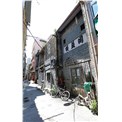
- Tung Yick Inn
Located in Yuen Long Kau Hui (Yuen Long Old Market), Tung Yick Inn once provided accommodation for travelling merchants from other localities. When the New Territories just came under British administration, members of Tai Ping Kung Kuk (Great Peace Public Council), an anti-British organisation, stayed there. Tung Yick Inn is a two-storey grey brick building. The mural and shop name on its facade remain intact.
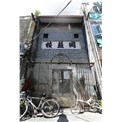
- Tung Yick Inn at present
Tung Yick Inn in Yuen Long Old Market at present.

- The Helena May
The Main Building of The Helena May was built in 1916. It originally served as a hostel for single female expatriates working temporarily in Hong Kong. During the Japanese Occupation (1941-1945), the Main Building was turned into a military dormitory of Japanese troops and the Hong Kong Citizen's Library. The Main Building exhibits a type of Edwardian Classical Revival architecture, with Beaus Arts, Baroque and Mannerist features.
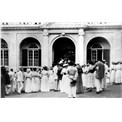
- The opening of The Helena May
The opening of The Helena May on 12 September 1916.
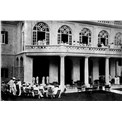
- Garden at the south side of the Main Building of The Helena May
Garden at the south side of the Main Building of The Helena May on 12 September 1916.
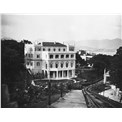
- Southwest side view of the Main Building of The Helena May
Southwest side view of the Main Building of The Helena May in 1916, with the Peak tramway on the right of the photo.
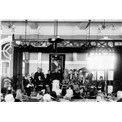
- Celebrating the fifteenth anniversary of the foundation of The Helena May
Photo taken at the Main Lounge of The Helena May on 18 February 1929, celebrating the fifteenth anniversary of the foundation of the institute. Ho Kom Tong, a prominent businessman and the main benefactor of The Helena May, was standing in the middle.
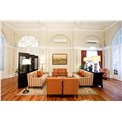
- Main Lounge of The Helena May
Main Lounge of The Helena May at present.
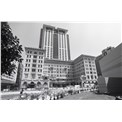
- The Peninsula
The Peninsula was officially opened in 1928, and it soon became the most popular rendezvous in Kowloon for the rich and famous. In 1941, the then Governor of Hong Kong, Sir Mark Aitchison Young, signed the instrument of surrender at the hotel. During the Japanese Occupation (1941-1945), the hotel was turned into the temporary command headquarters of the Japanese troops. In 1942, The Peninsula resumed business and was renamed the East Asia Hotel. After the Occupation, its original name was restored and it has continued to operate until the present.
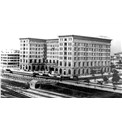
- The Peninsula in the past
The Peninsula overlooking Salisbury Road and Kowloon-Canton Railway, circa the 1930s.
Copyright © 2012 Hong Kong Memory. All rights reserved.
| Set Name |





